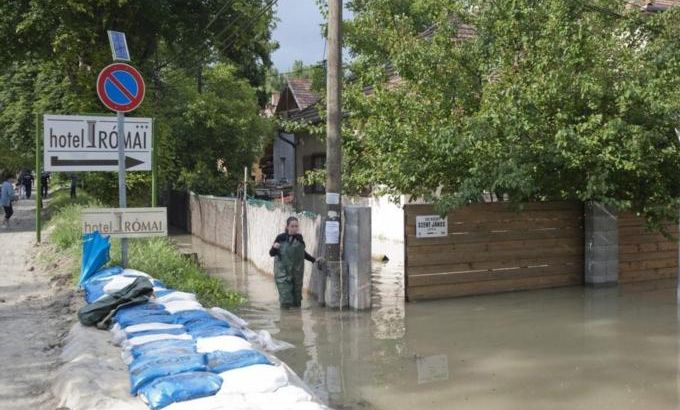Hungary defences hold as Danube level rises
Dykes strengthened and towns and villages evacuated, with river forecast to reach record levels in capital Budapest.

Hungary’s flood defences have continued to hold firm as Central Europe’s worst floods in a decade move through the northwest of the country and into the capital Budapest.
At least 21 flood-related deaths have been reported in Central Europe, as rivers such as the Danube, the Elbe and the Vlatava have overflowed after a week of heavy rains and caused extensive damage in central and southern Germany, the Czech Republic, Austria, Slovakia and Hungary.
Keep reading
list of 4 itemsAre seed-sowing drones the answer to global deforestation?
Rainfall set to help crews battling wildfire near Canada’s Fort McMurray
The Alabama town living and dying in the shadow of chemical plants
The latest fatality was an 80-year-old man who died of a heart attack in Austria on Sunday while cleaning up debris caused by flooding, the German news agency DPA reported.
So far Hungary has avoided the chaos seen elsewhere in Central Europe. Nevertheless, authorities said about 1,200 people had been evacuated from towns and villages along the Danube by Sunday afternoon.
The swollen river is forecast to peak around 8.96 metres in Budapest late on Sunday. By 13:00 GMT the water level in Budapest had hit a new record 8.90 metres, compared to the previous historic high of 8.60 metres recorded in 2006.
In a press conference on Margaret island, a popular park in the centre of the city and now surrounded by flood barriers of about 9.50 metres, Istvan Tarlos, Budapest’s mayor, said the water level was stabilising.
“Budapest is not at risk of a catastrophe, the level is not expected to rise significantly,” Tarlos said.
“There have been a number of leaking dykes around the city but this is normal and we have been able to solve any such situations.”
Barriers high enough
Authorities in Budapest said on Sunday the flood barriers now in place were high enough to protect even the most threatened parts of the city.
“Of course anything can happen, but we have every reason to believe that Budapest will survive its biggest flood of all time,” Imre Pesti, head of the city’s defence team, said.
Earlier on Sunday Viktor Orban, the prime minister, said “two very important days are ahead of us” as the flood approached Budapest, the most densely populated part of the country.
Speaking in the town of Esztergom 65km north of Budapest where he spent the night, he said the water level there had not increased for hours and that “the city is safe”.
The bridge linking Slovakia and Hungary at Esztergom was closed to traffic on Saturday.
Efforts will now focus on the defence of towns and villages between Esztergom and Budapest, he said.
In Budapest, water has covered roads running along the Danube since Wednesday, one metro station has been closed, while a special radio station, Flood FM, began broadcasting latest flood news on Saturday.
Authorities were forced to bring food and water supplies by boat to three villages cut off due to closed roads – Pilismarot, Domos and Kisoroszi.
A total of 44 roads have been closed in flood-affected areas while 24 towns and villages are without electricity.
Emergency personnel and volunteers worked non-stop overnight to prop up barriers and dykes as previous record water levels were toppled throughout northwest Hungary.
So far, around six million sandbags have been used in barriers along or close to the Danube.
By Sunday morning, however, water levels in several locations in northwest Hungary began to fall.
Fatality in Germany
In Germany, thousands of people had to be evacuated from their homes in a region in the country’s east where the Elbe River had flooded and burst through a dam, officials said on Sunday.
In Magdeburg, the state capital of Saxony-Anhalt, more than 23,000 residents had to leave their homes on Sunday afternoon after many streets and buildings were flooded and electricity was shut off.
The neighbourhood of Rothensee was especially hard-hit by the floods of the Elbe, with residents having to be evacuated with tanks, lorries and buses.
“Rothensee is filling up like a bathtub,” Andre Sabzog, Germany army spokesman, told DPA.
About 700 soldiers were trying to build a dam of sandbags around a power substation.
A flooding of the substation would not only leave thousands of households without water, but also lead to a breakdown of the neighbourhood’s dewatering pumps.
Another 8,000 people had been evacuated from the town of Aken and its neighbouring villages after a dam on the Elbe broke on Saturday, Uwe Holz, police spokesman, said.
Further north on the Elbe, residents were trying to protect themselves from flooding by building levees along the banks of the rising waterway.
Officials in Saxony-Anhalt also were investigating what appeared to be a threat to destroy dams.
Several media outlets said they had received a letter threatening to blow up dams on the Elbe, Holger Stahlknecht, the state’s interior minister, said on Sunday.
He said authorities had stepped up their surveillance of dams and urged residents to remain calm.